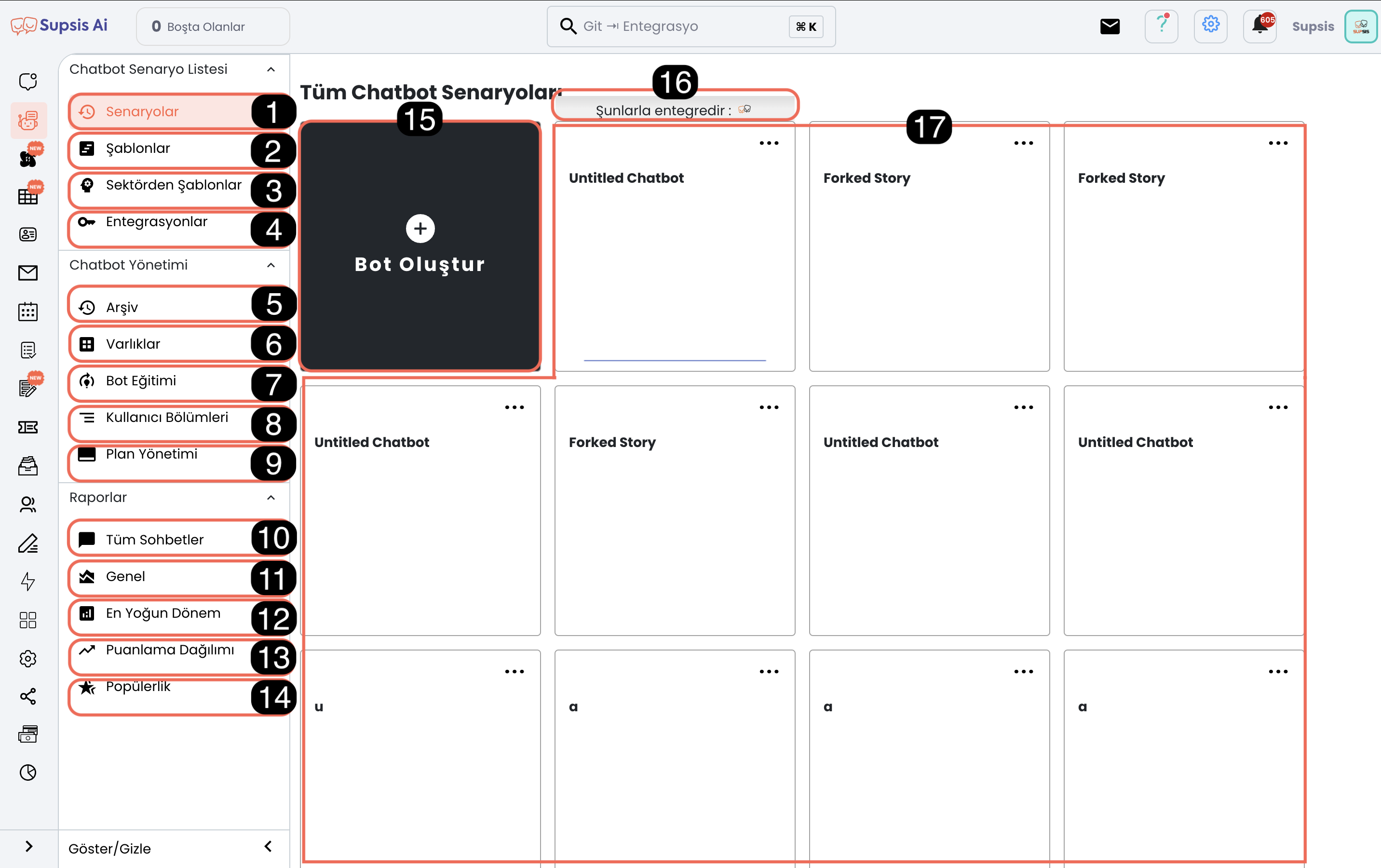Chatbot Menu
The Chatbot Menu provides a powerful infrastructure for businesses to manage and improve their interactions with customers through chatbots and artificial intelligence. Through this menu, you can create scenarios for chatbots, quickly put chatbots into use with quick configurations using industry-based ready templates, manage chatbot & communication channel integrations, and track detailed reports of all chat history of the chatbot. Additionally, you can increase the effectiveness of the chatbot with user segmentations and performance reports, and continuously improve the chatbot with the training module. The Chatbot Menu provides all the functions needed for businesses to manage customer relationships through chatbots.

Menu Items:
- Scenarios
- Templates
- Industry Templates
- Integrations
- Archive
- Entities
- Bot Training
- User Segments
- Plan Management
- All Chats
- Overall (General Performance)
- Busiest Period
- Scoring Distribution
- Popularity
- Create Bot
- Scenario Integration Channels
All Chatbot Scenarios
1-) Scenarios
You can access chatbot scenarios and the chatbot creation screen from this section. You can create different scenarios according to your needs, update existing scenarios and prepare alternative scenarios.
2-) Templates
Ready chatbot templates are used to better understand the working logic of the chatbot and to customize the templates according to your needs. You can select one of the templates in this section, make changes on them, experience how the system works and customize them according to your needs. By logging into the scenario and using the "Test Bot" option in the upper right, you can test your scenario and learn the chatbot logic.
3-) Industry Templates
These are templates specially prepared by the Supsis team for different industries. These templates are ready to use with minimal customization. The templates are optimized according to industry needs, thus enabling businesses to quickly activate their chatbots.
4-) Integrations
You can integrate your chatbot with different communication channels. From this menu, you can connect scenarios to the platforms you choose and spread the chatbot to a wider communication network.
5-) Archive
All conversations that the chatbot has with users are stored in this menu. In this section, you can access past chats and filter conversations according to specific criteria. This feature can be used to check chatbot competency, analyze customer requests and access past conversations.
6-) Entities
To increase the chatbot's understanding capacity, you can add new terms, synonyms and correct spellings from this section. This way, chatbot misunderstandings are prevented and more accurate responses are given.
7-) Bot Training
All situations where the chatbot cannot respond and understand will be stored in this menu according to popularity rate. The training process enables the chatbot to respond better to questions asked in the future. By training the bot, you can ensure its development and when it encounters situations it cannot respond to in subsequent processes, it can be directed to the correct chatbot block to give correct responses.
8-) User Segments
As a result of the analyses made by the chatbot, users can be segmented according to specific criteria. You customize these segments, analyze customer habits by getting reports according to your needs, and optimize customer segmentation.
9-) Plan Management
You can view the plan used by the chatbot and remaining chatbot sessions from here. By accessing plan details, you can examine chatbot usage quotas and limits.
10-) All Chats
Contains all chats performed by the chatbot and analyses of these chats. By examining chat records, you can get information about customer satisfaction and chatbot performance.
11-) Overall
Presents the total interaction and performance data of the chatbot. Reports details such as chatbot solution time, customer satisfaction evaluations, correct-incorrect matching rates according to training results.
12-) Busiest Period
Shows the periods when the chatbot is most active on a daily and hourly basis. This data helps you better understand customer densities and organize your service process accordingly.
13-) Scoring Distribution
Contains the score distribution where the chatbot's performance is measured. By seeing the feedback scores given by customers to the chatbot, you can evaluate the chatbot quality.
14-) Popularity
Shows the most used blocks in the chatbot. Popular blocks help you understand the operations or topics that users frequently request.
15-) Create Bot
This is the section used to create new chatbots or AI bots. From this area, you can quickly create a new bot and configure it according to your needs.
16-) All Chatbot Scenarios
You can see all the chatbot scenarios you have created in this section. By clicking the three dots in the upper right of the scenarios, operations such as deletion and copying can be performed on each scenario. When you copy the scenario from here, the first created version is copied. To copy the current version, you can copy the active version by entering the scenario, using the "Copy Diagram" option from the settings gear in the upper right, entering the chatbot menu and using Ctrl+V buttons.